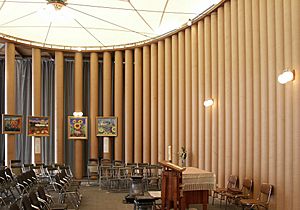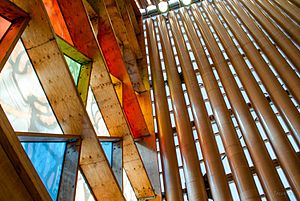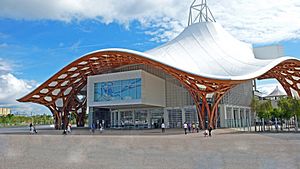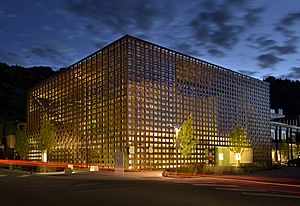Shigeru Ban facts for kids
Quick facts for kids
Shigeru Ban
|
|
|---|---|

Shigeru Ban, 2011
|
|
| Born | 5 August 1957 Tokyo, Japan
|
| Nationality | Japanese |
| Alma mater | Cooper Union for the Advancement of Science and Art |
| Occupation | Architect |
| Spouse(s) | Masako Ban |
| Awards | Pritzker Prize (2014) |
| Buildings | Centre Pompidou-Metz, France Cardboard Cathedral, Christchurch, New Zealand, Aspen Art Museum, US |


Shigeru Ban (坂 茂, Ban Shigeru, born 5 August 1957) is a famous Japanese architect. He is known for using unusual materials like paper and cardboard tubes in his designs. He often creates buildings that are temporary or can be put together quickly. Many of his projects help people after disasters.
In 2014, Ban won the Pritzker Architecture Prize. This is one of the most important awards in architecture. The judges praised him for his creative use of materials. They also recognized his efforts to help people around the world. They called him a great role model for young architects.
Contents
Early Life and Education
Shigeru Ban was born in Tokyo, Japan, on August 5, 1957. He studied architecture at the Southern California Institute of Architecture. Later, he went to Cooper Union's School of Architecture. He graduated from Cooper Union in 1984.
At Cooper Union, he learned from a teacher named John Hejduk. Hejduk taught Ban to think about architecture as "three-dimensional poetry." This idea helped Ban explore basic shapes and materials in new ways. His studies helped him find unique solutions for building structures.
Designing Buildings: Ban's Style
Shigeru Ban likes to make the structure of his buildings "invisible." This means he blends the support parts into the design. He doesn't want them to stand out too much. He chooses materials carefully to help show the main idea of his building.
Ban's work combines different styles. He uses ideas from traditional Japanese architecture. For example, he uses the idea of a "universal floor." This means floors stay at the same level throughout a house. This creates a smooth flow between rooms.
His Western education also influenced him. He learned to combine ideas from both Eastern and Western building styles. Ban is famous for using paper and cardboard tubes as building materials. He was the first architect in Japan to build a house mainly from paper. He even needed special permission to meet Japan's building rules.
Ban likes paper because it is cheap, can be recycled, and is easy to work with. It can also be replaced easily. He is also interested in sustainable and ecological architecture. This means his buildings are designed to be good for the environment. They produce very little waste.
His DIY (Do-It-Yourself) shelters for refugees are a great example. They were used after the Kobe earthquake in Japan. They also helped people in Turkey and Rwanda. These shelters are popular because they are low-cost and effective for disaster relief.
In 2000, Ban worked on the Japanese pavilion for Expo 2000 in Hanover, Germany. He worked with architect Frei Otto and engineers Buro Happold. The building was 72 meters long and made with paper tubes. After the exhibition, the structure was recycled back into paper pulp.
Ban's approach is often called "Paper Architecture." He sums up his philosophy by saying, "I don't like waste."
Using Paper as a Building Material

Ban started experimenting with paper tubes in 1986. He found that paper was much stronger than he expected. He also realized that paper tubes are available all over the world. They are often used in textile factories.
During disasters, building materials can be hard to find and expensive. Paper tubes are not a common building material, so they are cheaper and easier to get. For example, in Turkey in 1999, Ban even got paper tubes for free.
Paper tubes were also helpful during the Great Lakes refugee crisis in Rwanda in 1994. People were cutting down trees for shelters, causing deforestation. The United Nations tried using expensive aluminum pipes, but refugees sold them for money. So, they went back to cutting trees. Using paper tubes for frames saved money, prevented theft, and protected local trees.
After the big Great Hanshin earthquake hit Kobe, Japan, in 1995, Ban helped with rebuilding. His temporary shelters were cheap and easy to build. They also allowed communities to help construct them. These shelters offered better living conditions than tents.
The shelters were about 172 square feet. They had paper tube walls with small gaps for air. These gaps could be taped up for insulation. The roof was made of waterproof tent material. The foundation used donated beer crates filled with sandbags.
Ban's interest in using existing materials fit his minimalist ideas. He didn't need to invent new paper materials. He used existing technologies like waterproofing films and paints to improve paper's properties.
For "The Paper Dome" in 1998, Ban had to prove paper was a strong building material. He submitted a lot of engineering data to the government. This project used straight paper tube joists connected by wooden joints. Even though the joints were expensive, the low cost of the paper tubes kept the overall budget low. The paper tubes were also waterproofed to handle humidity changes.
The Japanese Pavilion at Expo 2000 in Germany also used paper tubes. These tubes were very long, about 67 feet, with a diameter of 4.75 inches. They were waterproofed inside and out. Surprisingly, the dense paper tubes were hard to burn. Ban designed the pavilion to be fully recyclable, fitting Expo 2000's theme of environmental awareness.
Instead of mechanical joints, fabric tape was used. This allowed for flexible movement and helped hold the structure together. The main tunnel of the pavilion was huge, measuring 242 by 82 by 52 feet. The fabric tape system allowed for easy building and taking down. Because of strict German building rules, the pavilion also included wooden parts. Ban also used recyclable wooden boxes filled with sand instead of a concrete foundation.
Shigeru Ban has said that the Japanese structural engineer Gengo Matsui was a big inspiration. Matsui helped him develop paper as a strong building material. Ban recalls that Matsui taught him to "see the structural engineering process visually."
Nepal Project
In July 2015, Ban started a project to rebuild homes in Nepal. This was for people affected by the earthquake that year. The new homes have flexible wood frames and brick walls. They are quick and easy to build. The people of Nepal can also use these buildings for other purposes, like schools.
Teaching and Influence
Shigeru Ban is a professor at Keio University. He has also taught at many other famous universities. These include Harvard University, Columbia University, and Cornell University. He has inspired many students with his unique ideas about architecture.
Selected Works


- Shutter House, New York City, USA
- Curtain Wall House (1995), Tokyo, Japan
- Naked House (2000), Saitama, Japan
- Japanese Pavilion (2000) at Expo 2000, Hannover, Germany
- Nomadic Museum (2005–present), designed for Gregory Colbert's "Ashes and Snow" exhibit
- Takatori Catholic Church, Kobe, Japan
- Paper Dome, Nantou, Taiwan
- Centre Pompidou-Metz museum, Metz, France
- Cardboard Cathedral, Christchurch, New Zealand (2012–2013)
- La Cité du Temps, Biel, Switzerland
- Aspen Art Museum, US
- Bamboo Furniture House, Great Wall, China
- Ōita Prefectural Art Museum, Ōita, Japan
- Onagawa Station, Onagawa, Japan
- La Seine Musicale, Boulogne-Billancourt, France
- Villa Vista, Weligama, Sri Lanka
- Tainan Art Museum, Tainan, Taiwan
Awards and Recognitions
- The JIA Prize for the Best Young Architect of the Year, Japan (1997)
- Time magazine Innovator of the Year, US (2001)
- Prix de l'Académie d'Architecture de France (2004)
- Arnold W. Brunner Memorial Prize in Architecture, American Academy of Arts and Letters, US (2005)
- Honorary doctorate degree of Technische Universitaet Muenchen, Germany (2009)
- Ordre des Arts et des Lettres, France (2010)
- Honorary Doctorate from The New School, US (2011)
- National Order of Merit, France (2011)
- Auguste Perret Prize for Technology Applied to Architecture (2011)
- Mainichi Design Prize, Japan (2012)
- Pritzker Architecture Prize (2014)
- Asia Game Changer Award (2014)
- World Economic Forum Crystal Award (2015)
- Princess of Asturias Award for Concord (2022)
See also
 In Spanish: Shigeru Ban para niños
In Spanish: Shigeru Ban para niños



